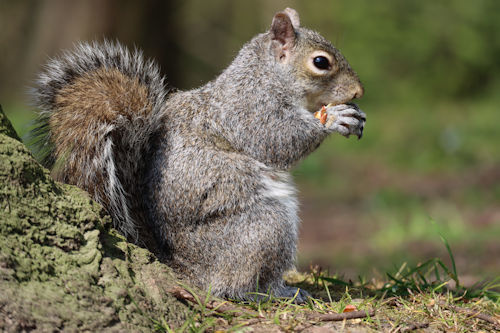Believe it or not, squirrels are rodents- a fancy, scientific way of saying they are tiny, furry (sometimes nocturnal), clawed creatures that scratch and gnaw. They typically live outside, but ever wonder how the squirrels get into your home’s attic in the first place?
Keep reading for the complete guide on squirrels in your attic.
How Squirrels Access Your Attic
Squirrels are known for their fantastic climbing abilities, making your home’s roof and soffits vulnerable areas for them to gain access to your attic. They are proficient climbers and can quickly scale trees and jump onto your roof. Once on the top, they start looking for weak spots to exploit to enter your attic.
One of the common ways squirrels enter your attic is by chewing through damaged shingles or vents. If your roof has missing or broken shingles, squirrels can easily rip them apart to create an entry point. Similarly, damaged or improperly installed vents provide a direct pathway for squirrels to squeeze through and reach your attic.
Soffits and Roof Edges
Moreover, squirrels target vulnerable areas such as soffits and roof edges. Soffits are the underside of the roof overhang and are generally made of wood or aluminum. These areas are often susceptible to damage, making them a prime target for squirrels. With their strong teeth, squirrels can gnaw through soffits, creating an opening to access your attic.
Fascia boards, the long horizontal bands that run along the eaves of your roof, are also at risk of being chewed through by squirrels. Many homeowners have reported squirrel-inflicted damage to fascia boards that allowed these critters to enter their attics. The availability of wood makes fascia boards appealing to squirrels as a potential entry point.
Though necessary for proper ventilation in your home, attic vents can unwittingly become entry points for squirrels. These vents are designed to allow airflow while preventing animals from getting inside. However, squirrels can exploit small gaps around the vents, causing damage. They may chew through or dislodge the vent covers, creating an entryway into your attic.
Humane Squirrel Removal
Once you have identified the presence of squirrels in your attic, removing them using humane methods is vital. Employing humane practices ensures that the animals are not harmed during removal. It is essential to approach wildlife control with empathy and respect for the creatures that have found shelter in your home.
The first step in humane squirrel removal is to identify the exit points the squirrels are using. You can strategically plan the removal process by understanding their patterns and paths. Determining where the squirrels are coming in and out of your attic is crucial, ensuring they have a safe way to leave without becoming trapped.
Sealing Entry Points
After the squirrels have left, it is necessary to seal all entry points to prevent future infestations. Inspect your roof, soffits, fascia boards, and attic vents for any openings. Use materials such as metal mesh, heavy-duty wire, or sealant to close off these entry points. It is essential to ensure a tight and secure seal to keep squirrels from reentering your attic.
Using deterrents is another effective way to discourage squirrels from returning. Motion-activated lights or sprinkler systems can startle and prevent squirrels, making them less likely to revisit your home. Additionally, trimming tree branches that provide easy access to your roof can make it more difficult for squirrels to reach your attic.
Preventing Squirrel Infestations
Preventing squirrel infestations is critical to ensuring the safety and integrity of your home. Taking proactive measures can minimize the risk of squirrels entering your attic.
One effective preventive measure is to trim trees and branches near your house. Squirrels use tree limbs as natural highway systems, allowing them to jump onto your roof quickly. Keeping units at least six to eight feet away from your top can significantly deter squirrels, making it more challenging for them to access your attic.
Chimney Caps and Screens
Installing chimney caps and screens can also help prevent squirrel infestations. Squirrels are known to enter attics through chimneys, especially if they are not adequately protected. Chimney caps and screens act as barriers, blocking squirrels from entering your home through the chimney.
Securing trash and bird feeders is another essential step in preventing squirrel infestations. Squirrels are attracted to food sources, so it is necessary to minimize their accessibility to these temptations. Ensure your trash cans are tightly sealed and not easily accessible to squirrels. Using squirrel-proof bird feeders can also help keep these creatures away from your property.
Repairing Squirrel Damage
Squirrels can cause extensive damage to your home’s attic. The destruction they create can be a nightmare for homeowners, from chewing on electrical wires to tearing apart insulation. Repairing squirrel damage is crucial to maintaining the structural integrity of your home and ensuring your family’s safety.
Start by assessing the extent of the damage in your attic. Look for chewed wires, ripped insulation, and gnawed structural elements. To determine the necessary repairs, it is essential to understand the damage caused by squirrels comprehensively.
Replacing Insulation
While homeowners can repair minor squirrel damage, extensive damage may require professional assistance. Consulting professionals specializing in wildlife damage repairs can ensure that the repairs are done correctly and efficiently. These professionals have the necessary knowledge, experience, and tools to restore your attic to its original condition.
If squirrels have used insulation materials for nesting or have contaminated the insulation in any way, it is essential to remove and replace it. Heavily soiled or destroyed insulation can compromise the thermal performance of your home and leave it vulnerable to extreme temperatures. This step is essential in ensuring energy efficiency, proper insulation, and comfortable living conditions within your home.
Protect Your Home From Squirrels in Attic
In conclusion, understanding how squirrels gain access to your home’s attic is the first step in preventing and addressing infestations. You can safeguard your home from these pesky intruders by employing humane squirrel removal methods, taking preventive measures, and promptly repairing any squirrel damage. Treating wildlife respectfully and prioritizing their well-being while protecting your living space is essential.
If you are facing a squirrel infestation in your attic, don’t hesitate to give us a call for expert assistance. Our team of professionals specializes in humane squirrel removal and can help you restore your home to its squirrel-free state. Take action now to protect your home and ensure a safe living environment for you and your family.

